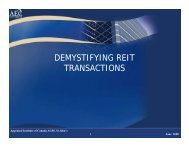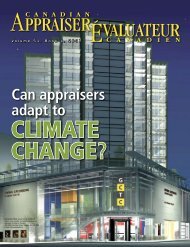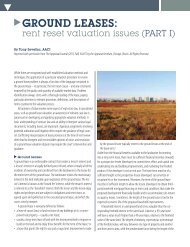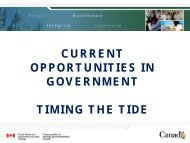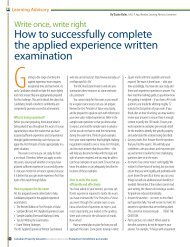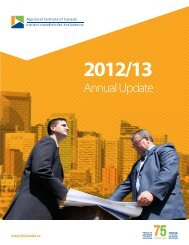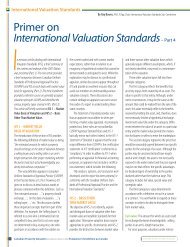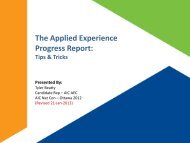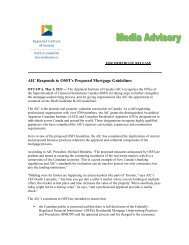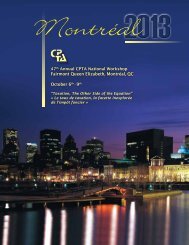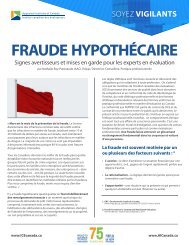Book 1 - Appraisal Institute of Canada
Book 1 - Appraisal Institute of Canada
Book 1 - Appraisal Institute of Canada
Create successful ePaper yourself
Turn your PDF publications into a flip-book with our unique Google optimized e-Paper software.
the building (mould or asbestos), copies <strong>of</strong> all leases (if an incomeproducing property), any outstanding work orders, barrier free issues,code compliance, estoppel certificates for tenants, confirmation <strong>of</strong>chattels vs. fixtures, special local improvement charges, property taxes,confirmation <strong>of</strong> building permits, etc.Whole-life costingWhole-life costing 6 is a key component in the economic appraisalassociated with evaluating asset acquisition proposals. An economicappraisal is generally a broader based assessment, considering benefitsand indirect or intangible costs as well as direct costs.In this way, the whole-life costs and benefits <strong>of</strong> each option areconsidered and usually converted using discount rates into present-valuecosts and benefits. This results in a benefit-cost ratio for each option,usually compared to the ‘do-nothing’ counterfactual. Typically, thehighest benefit-cost ratio option is chosen as the preferred option.As part <strong>of</strong> this analysis, the cost <strong>of</strong> capital relative to businessopportunity costs is an important consideration for the private sector,and could result in choosing another option such as leasing. Withrespect to the public sector, this would be balanced with the four pillarsapproach and it is also recognized that the cost <strong>of</strong> capital is less than theprivate sector.The whole-life costing model includes for the periodic lifecycle(capital) replacement <strong>of</strong> major components and systems, which, in turn,establish the cradle to grave requirement for measuring and managinga physical asset’s useful life. A whole-life costing model can assist indetermining the true value <strong>of</strong> any leveraging opportunity and to ensurethe proper balance <strong>of</strong> risk and opportunity in structuring any leveragingarrangement.Simply put, whole-life costing is analyzing the ‘true cost <strong>of</strong>ownership.’ This is demonstrated with Figure 2 – Developing Whole-Life Cost Pr<strong>of</strong>iles for Facilities:Operation/maintenanceAt this stage property management pr<strong>of</strong>essionals who are responsiblefor overseeing the day-to-day operations typically maintain theproperty. Examples include: custodial services, maintenance and dealingwith tenants.At a more strategic level, the ownership will require a business planfor each property, which requires an ongoing review <strong>of</strong> the real propertyinventory; it also requires financial reporting to the ownership on aregular basis.As part <strong>of</strong> any effective asset management plan, an accurateinventory is required to describe all real property assets. The inventorydatabase should be updated on a continuous basis. In addition, aninventory review should include a review <strong>of</strong> all leases or lease abstracts,rents, operating costs, lease rollovers, tenant relocation, additional rightssuch as a First Right <strong>of</strong> Refusal or Right to Purchase, etc.Useful Life <strong>of</strong> the FacilityDeveloping Whole-Life Cost Pr<strong>of</strong>iles for FacilitiesDEFINE THE NEEDFOR THE ASSETFACILITY DESIGNAND CONSTRUCTIONCOSTSFINANCING COSTS(IF APPLICABLE)OPERATING COSTSPLUS ANNUALESCALATIONLIFE CYCLE ANDPLANNED CAPITALRENEWAL COSTS PLUSANNUAL ESCALATIONPLANNEDIMPROVEMENT COSTS(discretionary)DEMOLITION ANDSITE CLEANUP COSTS(discretionary)This includes the cost for any purchasedland parcel(s), plus any built improvementswhich might be required. Costs for anypre-existing demolition should also bereflected here.This is the full cost for design developmentand actual construction <strong>of</strong> the requisitefacility.This item includes the full cost <strong>of</strong> financingthe acquisition, design and constructionphases <strong>of</strong> the project over the full termthat financing is applicable.These are identified annual operatingcosts, plus a reasonable escalation factorover the entire useful life <strong>of</strong> the facility.This is the requisite program <strong>of</strong> plannedlife cycle capital renewal for the builtfacility type. Typically applies for theentire useful life <strong>of</strong> the facility andincludes an annual escalation factor.These cost are discretionary andrepresent any planned improvements tothe facility typically completed on aone time basis at some point in its totallife cycle.One time demolition and site cleanup costsoccurring at the end <strong>of</strong> the facility life andprior to sale or disposition. May not applyif facility and land are sold as-is, where-is.44Canadian Property Valuation Volume 54 | book 1 | 2010 Évaluation Immobilière au <strong>Canada</strong>click here to return to table <strong>of</strong> contents



